| |
Sub Bases: Holy Loch, Scotland |
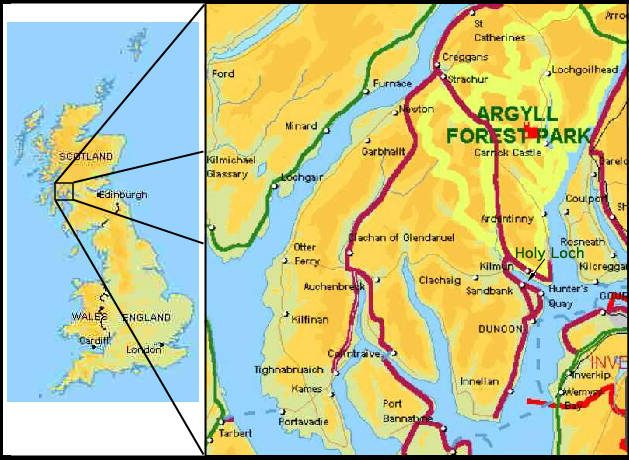 |
| USS Proteus (AS-19) established the United State's first forward deployment FBM Submarine base at Holy Loch, Scotland March 1, 1961. In an effort to counter the intercontinental ballistic missile threat then posed by the Soviet Union, the United States had designed and constructed a mobile nuclear force. However - since the "range" of that force was (then) roughly 1500 miles, the United States needed to deploy that force close to it's intended target. In cooperation with Britsh and Scotish Authorities, Holy Loch became that forward station. Lee Hein served aboard 5 Tenders, Four Sites plus Cape Canaveral, and worked on more boats than he can count. His 22 year (so far) career started as a Missile Technician in the Navy for 8 years, then after he left the Navy, continued to serve the FBM fleet as a TechRep (Definition: Technical Representative - an on-site Guru who works for a defense contractor, providing technical advice, expertise, and as an official "go between" for the company in dealing with Navy personnel). Much of his time was spent at the Loch - and he has kindly shared many wonderful photos of that time and place. |
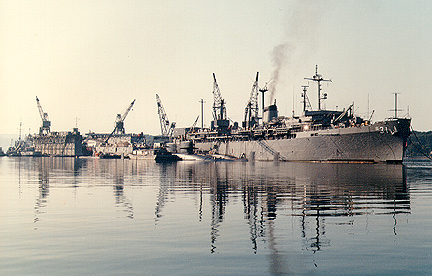 |
| This is a shot of the Hunley AS-31 at the Loch. Can you find the five submarines in the picture? There are three on the stb. side, one in the dry dock, and the NR-1 is along the YFNB-42 (the barge between the tender and dry dock). Along side the Los Alamos (the dry dock) is the sub rescue ship Sunbird ASR-15. The NR-1 is very slow, something along the lines of 5 kts, so it gets towed by the Sunbird everywhere. Site One also had three YTB tugs assigned which are outboard the Sunbird in the picture. There is a barge outboard the three SSBNs that are alongside the AS-31. |
| |
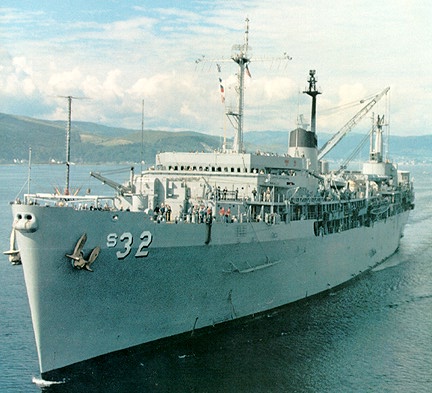 |
| USS Holland AS-32 underway in the Loch... |
| |
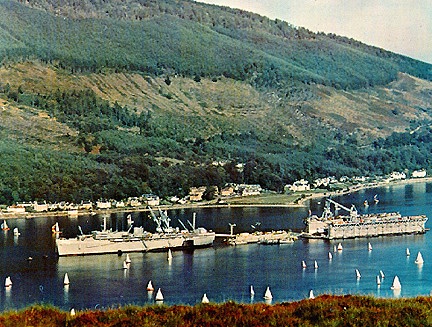 |
| This is a shot from the hills behind the village of Sandbank. This shot was probably taken in the summer of '76, maybe as late as '77. There is only one barge between the dry dock and tender (USS Holland AS-32). The barge is the YFNB 31. The village in the background is Kilmun. Look how close we were to residences. Imagine handling nuclear weapons in a residental neighborhood. Some of the Scots' complaints about us were justified. Would you allow that in your neighborhood? |
| |
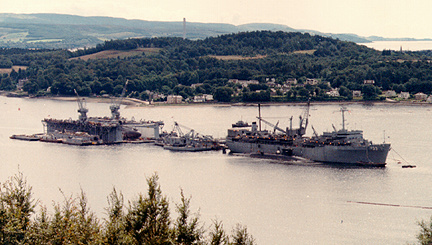 |
| This is a shot of the Simon Lake (AS-33) taken fronm the hill behind the village of Kilmun sometime between June 87 and September 91. The River Clyde, headed towards the sea, is that bit of water that is visable to the right on the otherside of the point. The floating crane is moored alongside the YFNB-42. When I was a tech rep, my office was on the second deck of the YFNB-42. |
| |
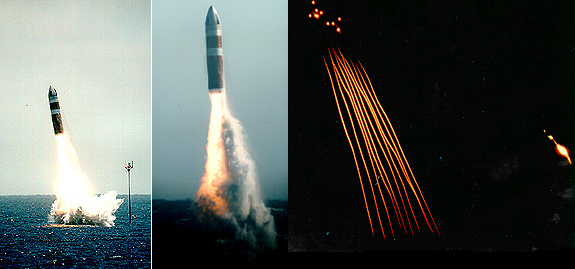 |
| The left hand photo is a C3 DASO launch. Note the TI mast to the right. The middle photo is another shot of a C3 DASO launch. The right hand photo -the REBs re-entering the atmosphere, and are from the last C3 OT/FOT done out of the Holy Loch. I can't remember what boat we were working on. It might have been the 622. In the picture the REBs are clearly visible. The bright spot on the far right is the equipment section burning-up |
Webmaster's note - this is what FBM "Deterrence" is all about - folks. The FBM's sole purpose in life - to launch a retaliation against an agressor - each missile can deliver ten (count 'em) war heads... (note in the picture one REB is behind another - notice the trails just above...). Chilling picture - when you realize that in the "real thing" there would be several mega-tons of destruction at the bottom of each of those pretty "fireworks trails"... The (former) Soviet Navy couldn't find our boomes (FBMs) - they knew where our planes were - and what their course would be- they knew where our ICBM missiles were - had a hunch they could "handle" them - but those damn boomers... Silent, mobile, could strike from anywhere. THOSE made the difference in the "cold war". |
| Portions © 1997 Lee Hein. Posted to TenderTale with his written permission. |
| Go Back to Deployments - Charleston | Continue on to Deployments - Rota |
| Return to TenderTale Main Page © 2006 Common Cents Computers | |